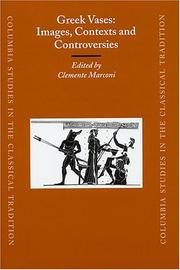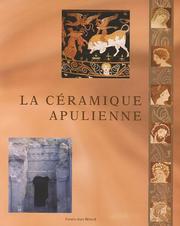| Listing 1 - 5 of 5 |
Sort by
|

ISBN: 9004138021 9789004138025 9786610914999 9047405145 1280914998 1429427507 9781429427500 9781280914997 6610914990 9789047405146 Year: 2004 Volume: 25 Publisher: Leiden Brill
Abstract | Keywords | Export | Availability | Bookmark
 Loading...
Loading...Choose an application
- Reference Manager
- EndNote
- RefWorks (Direct export to RefWorks)
This volume deals with Greek painted vases, exploring them from various methodological points of view and moving beyond the traditional focus on connoisseurship and style. The volume, which represents the proceedings of an international conference sponsered by the Center for the Ancient Mediterranean at Columbia University, is an effort to exploit the immense richness of these vases by using them to study general cultural history.
Conferences - Meetings --- Vases, Greek --- Vase-painting, Greek --- Vases grecs --- Peinture de vases grecque --- Congresses --- Congrès --- Greek vases --- Greek vase-painting --- Vases [Greek ] --- Vase-painting [Greek ] --- Congresses.
Book
ISBN: 9789004371200 9004371206 9004371184 9789004371187 Year: 2018 Publisher: Leiden Boston
Abstract | Keywords | Export | Availability | Bookmark
 Loading...
Loading...Choose an application
- Reference Manager
- EndNote
- RefWorks (Direct export to RefWorks)
As the first extensive survey of the ancient Greek painters’ practice of writing nonsense on vases, The So-called Nonsense Inscriptions on Ancient Greek Vases by Sara Chiarini provides a systematic overview of the linguistic features of the phenomenon and discusses its forms and contexts of reception. While the origins of the practice lie in the impaired literacy of the painters involved in it, the extent of the phenomenon suggests that, at some point, it became a true fashion within Attic vase painting. This raises the question of the forms of interaction with this epigraphic material. An open approach is adopted: “reading” attempts, riddles and puns inspired by nonsense inscriptions could happen in a variety of circumstances, including the symposium but not limited to it.
E-books --- Vases, Greek --- Inscriptions, Greek. --- Greek inscriptions --- Greek language --- Greek philology --- Inscriptions on Greek vases --- Inscriptions --- Inscriptions. --- Vases grecs --- Inscriptions grecques.
Book
ISBN: 3110458020 311045842X 9783110458435 3110458438 9783110458022 9783110458428 9783110456097 3110456095 Year: 2016 Publisher: Berlin
Abstract | Keywords | Export | Availability | Bookmark
 Loading...
Loading...Choose an application
- Reference Manager
- EndNote
- RefWorks (Direct export to RefWorks)
The ancient typology of Greek vases has long been a difficult and important issue of discussion for the scholars of the ancient world. The gap between verba and realia is great, as objects usually come without labels and labels without objects. Thus, not a large number containers may be satisfactorily identified with the corresponding objects. At the same time, the analysis of the technical vocabulary of the containers in the papyri is a desideratum in papyrology. The present study provides a detailed analysis of a representative sample of terms denoting containers used for the transport and storage of spices, food, and medicinal drugs. Papyri are the starting point, as they are a treasure-trove of concrete linguistic information and yield new insights into the nature and the diachronic development of Greek vocabulary. The methodology employed in this study is interdisciplinary. It involves critical and comparative examination of the written sources (papyri, literary passages, inscriptions, tituli picti) and the archaeological artefacts, and allows the revaluation of the entire material at our disposal. This interdisciplinary approach provides a useful tool for the study of the language and material culture of the Graeco-Roman world.
Vases, Greek. --- Manuscripts, Greek (Papyri) --- Greek language --- Classical languages --- Indo-European languages --- Classical philology --- Greek philology --- Greek papyri --- Papyri, Greek --- Manuscripts, Classical (Papyri) --- Manuscripts (Papyri) --- Greek vases --- Vases grecs --- Papyrus grecs --- Grec (Langue) --- Archaeology. --- antique vases. --- papyrology.
Book

ISBN: 9782918887164 2918887161 2380500169 Year: 2019 Volume: 9 Publisher: Naples : Publications du Centre Jean Bérard,
Abstract | Keywords | Export | Availability | Bookmark
 Loading...
Loading...Choose an application
- Reference Manager
- EndNote
- RefWorks (Direct export to RefWorks)
Ce volume constitue les actes d’un colloque organisé à l’ENS de Lyon (19-20 janvier 2012) pour mettre à l’honneur ce poète oublié, dans des échanges pluridisciplinaires autour de cette œuvre très peu lue en dehors d’un cercle restreint de spécialistes. En réunissant les contributions de philologues, historiens de l’art et historiens des idées, ce volume s’efforce d’enrichir le commentaire des fragments et tente de comprendre les usages que ce poète a faits de la matière mythologique dans une perspective politique ou pour rendre compte du monde dans lequel il évoluait. La première partie de l’ouvrage propose deux parcours géographiques pour donner une idée du traitement du mythe par Euphorion, allant d’abord au sein de la Grèce traditionnelle d’Eubée en Béotie et de l’Attique en Corinthie, puis parcourant l’Asie mineure et le Proche-Orient où Euphorion a fait lui-même une partie de sa carrière. La seconde partie plus littéraire essaie de mettre en lumière certains aspects propres de la poétique d’Euphorion au sein d’un ensemble de poètes qui recherchent l’obscurité, l’étrange ou la rareté et dans l’art spécifique de la malédiction.
Euphorion, --- Mythology, Greek, in art --- Mythologie grecque dans l'art --- Mythology, Greek --- Criticism and interpretation --- Vases, Greek --- Vases grecs --- Themes, motives --- Congresses --- Thèmes, motifs --- Congrès --- Congresses. --- Greek mythology --- Euforió, --- Euforión, --- Euforione, --- Mythology, Greek - Congresses --- Euphorion, - of Chalcis, - approximately 276 B.C.- - Criticism and interpretation - Congresses --- époque hellénistique --- poésie grecque --- mythe grec --- Euphorion, - of Chalcis, - approximately 276 B.C. --- -Mythology, Greek


ISBN: 9782903189815 2903189811 2918887897 Year: 2005 Publisher: Naples Centre Jean Bérard
Abstract | Keywords | Export | Availability | Bookmark
 Loading...
Loading...Choose an application
- Reference Manager
- EndNote
- RefWorks (Direct export to RefWorks)
Pottery, Italic --- Pottery, Ancient --- Vases, Red-figured --- Vases, Apulian --- Vases, Greek --- Céramique italique --- Céramique antique --- Vases à figures rouges --- Vases apuliens --- Vases grecs --- Congresses --- Congrès --- Puglia (Italy) --- Pouilles (Italie) --- Antiquities --- Antiquités --- Céramique italique --- Céramique antique --- Vases à figures rouges --- Congrès --- Antiquités --- Red-figure vases --- Red-figured vases --- Vases, Red-figure --- Vases, Ancient --- Greek vases --- Apulian vases --- Vases --- Italic pottery --- Ancient pottery --- Pottery, Prehistoric --- Apulia (Italy) --- Puglie (Italy) --- Apulie (Italy) --- Conferences - Meetings --- Congresses. --- Pulia (Italy) --- Απουλία (Italy) --- Apoulia (Italy) --- Púgghie (Italy) --- Puie (Italy) --- Puje (Italy) --- Puia (Italy) --- Poulye (Italy) --- Pottery --- céramique italiote --- céramique apulienne
| Listing 1 - 5 of 5 |
Sort by
|

 Search
Search Feedback
Feedback About UniCat
About UniCat  Help
Help News
News